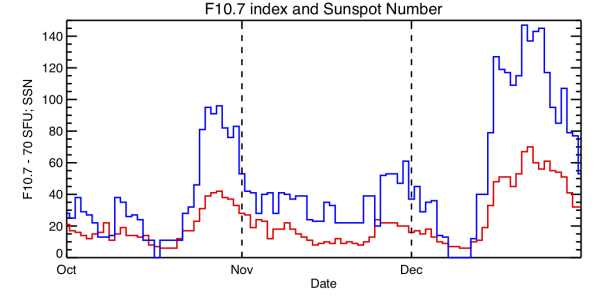Disk Occultation of a Lopsided Sun
| Nugget | |
|---|---|
| Number: | 424 |
| 1st Author: | Hugh HUDSON |
| 2nd Author: | Stephen WHITE and Säm KRUCKER |
| Published: | 10 January 2021 |
| Next Nugget: | TBD |
| Previous Nugget: | Resolving two distinct thermal X-ray components in a compound solar flare |
Introduction
As solar magnetic activity increases with the beginning of Solar Cycle 25, we are seeing extreme variations of solar activity on the time scale of the period of roughly one month (Carrington determed the sidereal period from sunspot motions to be 25.38 days). The general behavior of solar rotation is interestingly complicated. This lopsided behavior may be a common feature of early and late phases of solar cycles, in which one face of the Sun may have multiple active regions while the other face does not. We are unaware of any actual literature on this topic, but it is clearly a manifestation of the highly non-random nature of all aspects of solar magnetic activity.
Characterizing the lopsided sun
We can roughly characterize the lopsidedness of the Sun by using the well-established F10.7 index of microwave emission variability. Figure 1 shows the behavior of this index during the last quarter of 2021, a period in which sometimes there were no sunspots at all, and other times when there were many. This results in three striking peaks in the time series.

Note that in Figure 1 we have subtracted 70 SFU, roughly the "basal" level of the solar coronal emission in the absence of magnetic activity. Also as a caveat we will note that the sunspot number is a highly nonlinear measure. But the basic point is clear: observing a blank Sun may reveal interesting things in the corona seen "above" the limb.
Why occultation matters
Many key observations from space treat the Sun as a star, or else have saturation problems with bright features such as flares or solar active regions. These limitations may obscure faint but very interesting developments in the solar corona. For an event originating on the solar hemisphere invisible to one of these instruments, the coronal emission may be detectable while its bright counterparts are occulted, as illustrated in Figure 1. The powerful microwave/hard X-ray event SOL1969-03-30 (Ref. [1]) was an early example of this.

The basic observing scheme to take advantage of a lopsided Sun is the following: Observe when a hot active region (sunspot group) emerges on the far side but nearing the East limb (from the observatory's perspective), or has just rotated past the West limb, This selection is important because many of the most sensitive observatories are of course heavily oversuscribed by eager observers, and the identification of a window of opportunity with a good probability of successful observation is definitely important.
Conclusion
The scheduling of solar observations by some prime observing facilities in space (such as NuSTAR, for example, but there are many others), can really benefit from scheduling during an interval when the Sun is lopsided. This is an exciting time, when we have not only STEREO but also Solar Orbiter and Parker Solar Probe all in heliocentric orbits and capable of contributing to stereoscopic astronomy.
References
[1] "Evidence from Hard X-Rays for Two-Stage Particle Acceleration in a Solar Flare"